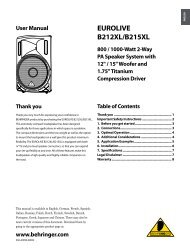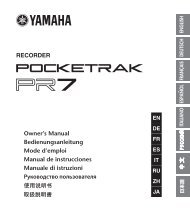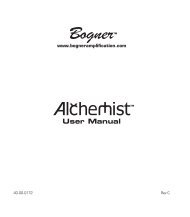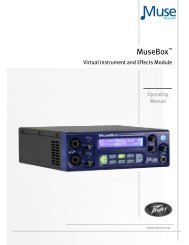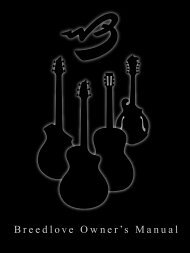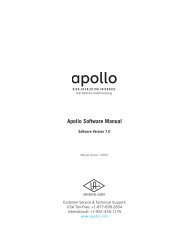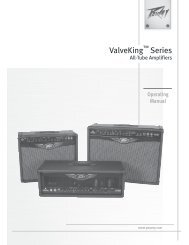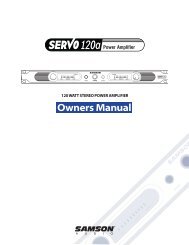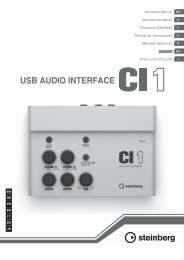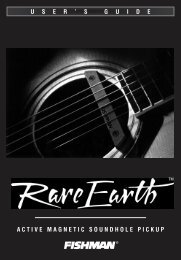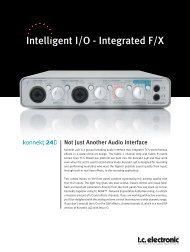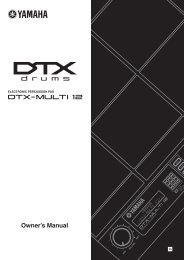microARRANGER Quick Start Guide - Korg
microARRANGER Quick Start Guide - Korg
microARRANGER Quick Start Guide - Korg
Create successful ePaper yourself
Turn your PDF publications into a flip-book with our unique Google optimized e-Paper software.
Front panel<br />
The music stand<br />
4<br />
8 MEMORY (TIE)<br />
This button turns the Lower and Chord Memory functions on<br />
or off. Go to the “Page 24 ‐ Preferences: controls” edit page to<br />
decide if this button should be a Chord Memory only, or a<br />
Lower/Chord Memory button. When it works as a Lower/<br />
Chord Memory:<br />
O N<br />
OFF<br />
The sound to the left of the split point, and the<br />
chord for the automatic accompaniment, are<br />
kept in memory even when you raise your<br />
hand from the keyboard.<br />
The sound and chords are released as soon as<br />
you raise your hand from the keyboard.<br />
This button doubles as a TIE function for the Song mode.<br />
9 BASS INV. (REST)<br />
This button turns the Bass Inversion function on or off.<br />
ON<br />
OFF<br />
The lowest note of a chord played in inverted<br />
form will always be detected as the root note of<br />
the chord. Thus, you can specify to the arranger<br />
composite chords such as Am7/G or “F/C”.<br />
The lowest note is scanned together with the<br />
other chord notes, and is not always considered<br />
as the root note.<br />
This button doubles as a REST function for the Song mode.<br />
10 MAN. BASS<br />
This button turns the Manual Bass function on or off.<br />
Note: When you press the MAN. BASS button, the Bass track volume<br />
is automatically set to the maximum value. The volume is<br />
automatically set back to the original value when the MAN. BASS<br />
button is deactivated.<br />
ON<br />
OFF<br />
The automatic accompaniment stops playing<br />
(apart for the Drum and Percussion tracks),<br />
and you can manually play the Bass track on<br />
the Lower part of the keyboard. You can start<br />
the automatic accompaniment again by pressing<br />
one of the CHORD SCANNING buttons.<br />
The bass track is automatically played by the<br />
Style.<br />
11 SPLIT POINT ()<br />
Press this button to open the Groove Quantize window,<br />
where you can select a realtime groove quantization to be<br />
applied to the Song (only Sequencer 1).<br />
This button doubles as a NEXT EVENT function for the<br />
Backing Sequence and Song modes.<br />
13 TEMPO (= LOCK)<br />
This button turns the Tempo Lock function on or off.<br />
ON<br />
OFF<br />
When you select a different Style or Performance,<br />
the tempo doesn’t change. You can still<br />
change it using the DIAL or the TEMPO buttons.<br />
When you select a different Style or Performance,<br />
the memorized tempo value is automatically<br />
selected.<br />
14<br />
This button turns the Single Touch function on or off.<br />
ON<br />
OFF<br />
SINGLE TOUCH<br />
When a different Style (or the same again) is<br />
selected, a Single Touch Setting (STS1) is automatically<br />
selected, meaning that the Realtime<br />
tracks and effects will change, together with<br />
the Style tracks and effects.<br />
When you select a different Style (or the same<br />
again), the Style tracks and effects are changed,<br />
while the Realtime tracks are not changed.<br />
15 STYLE section (NUMERIC KEYPAD)<br />
Use these buttons to open the Style Select window and select<br />
a Style. See “Selecting a Style” on page 14.<br />
The leftmost button lets you select the upper or lower row of<br />
Style banks. Press it until you’ve selected the row you’re looking<br />
for. (After both LEDs have turned on, press the button<br />
again to turn them off).<br />
UPPER LED ON<br />
LOWER LED ON<br />
Upper‐row Styles selected.<br />
Lower‐row Styles selected.<br />
A word about Style banks and names. Styles from “8/16<br />
BEAT” to “WORLD 3”, and from “LATIN1” to “TRAD” are<br />
standard Styles, the user can’t normally overwrite with a<br />
Load operation.<br />
“DIRECT SD” Styles are Styles directly accessed from the<br />
memory card (no need to load from card).<br />
Styles from “USER1” to “USER3” are locations where you<br />
can load new Styles from the memory card.<br />
Each button (Style bank) contains 2 pages, each with up to 8<br />
Styles. Browse through the Styles using the PAGE buttons.<br />
There is a shortcut to see the original bank for a Style. You<br />
can see the original bank where a Style is contained. Just keep<br />
the SHIFT button pressed, and then press the lefmost button of<br />
the STYLE section. A message window will appear, showing<br />
the name of the original bank. Release the SHIFT button to exit<br />
the window.<br />
There is a shortcut to see all pages of the selected bank. To<br />
cycle all pages for a selected bank, press the bank’s button<br />
until you see the page that you’re looking for.<br />
These buttons double as a numeric keypad on certain pages.<br />
16 FADE IN/OUT<br />
When the Style stopped, press this button to start it with a<br />
volume fade‐in (the volume goes from zero to the maximum).<br />
When the Style is playing, press this button to stop it with a<br />
volume fade‐out (the volume gradually decreases).<br />
You don’t need to press START/STOP to start or stop the Style.<br />
17 VARIATION 1–4 (NOTE LENGTH) buttons<br />
Each of these buttons will select one of the four variations of<br />
the current Style. Each variation can vary in patterns and<br />
sounds.<br />
These buttons double as a NOTE LENGTH function for the<br />
Song mode.<br />
18 FILL 1–2 (NOTE LENGTH) buttons<br />
These two buttons trigger a fill‐in. Press them twice (LED blinking)<br />
to let them play in loop, and select any other Style element<br />
(Fill, Intro, Variation…) to exit the loop.<br />
They also double as a NOTE LENGTH function for the<br />
Song mode.



